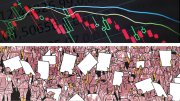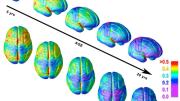On January 21, 2017, millions of people gathered across the country for the Women’s March—at that point, the largest single-day protest in American history. Amid disputes about the number of participants, Jeremy Pressman, a professor at the University of Connecticut, and Erica Chenoweth, then a professor at the University of Denver and now a professor at Harvard Kennedy School (HKS), wanted to provide an accurate estimate. They teamed up to count the number of people at the protests, basing the count on crowdsourced reports that were validated by sources such as photos, law enforcement statements, and event pages on social media. They ultimately estimated that between three to five million people protested at more than 650 different locations across the country.
Out of that effort grew the Crowd Counting Consortium (CCC), a joint project of the University of Connecticut and the Nonviolent Action Lab, a program run by HKS’s Ash Center for Democratic Governance and Innovation. The consortium collects publicly available data on political crowds, such as protests, marches, and strikes. The timing of the CCC’s creation was prescient: “In the last seven or eight years, we’ve seen some of the largest and broadest mass mobilizations in our history,” says Chenoweth, co-director of the CCC and the Stanton professor of the First Amendment at HKS and Wallach professor at the Radcliffe Institute. These mobilizations have spanned issues from abortion to racial justice—and now, since the outbreak of war in Gaza, protestors are organizing to express support for Israel and Palestine.
On December 5, experts from the CCC spoke about the protest data they have collected thus far. The webinar, “5 Things Journalists Need to Know About Pro-Israeli and Pro-Palestinian Protests in the U.S.,” was hosted by HKS’s Shorenstein Center on Media, Politics and Public Policy.
One insight journalists can glean from these data, the speakers said, is how the protests have evolved since Hamas’s October 7 attack on Israel. Since then, the CCC has recorded almost 2,600 actions in support of either Israel or Palestine, with more than a million participants. But those actions haven’t been equally distributed: in the period between October 7 and November 28, the CCC recorded 433 rallies in support of Israel and 1,869 in support of Palestine. “While the pace and size of public gatherings in solidarity with Israel have declined significantly since the initial surge in early to mid-October,” said research project manager of the Nonviolent Action Lab Jay Ulfelder, “actions in support of Palestine have swelled into a geographically broad and demographically and tactically diverse movement that continues to produce scores of events with hundreds or thousands of total participants just about every day.” Who is attending these protests can also provide insight. “We’ve seen elected officials at a much larger share of the pro-Israel events than the pro-Palestine ones—almost 25 percent compared with less than 2 percent of the pro-Palestine events,” Ulfelder said.
The CCC’s data can also help in comparing this wave of protests to historic ones. “We’re fairly confident at this point that this year’s pro-Palestine wave is the largest and broadest pro-Palestine mobilization in U.S. history,” Ulfelder said. It is “already much larger” than the swell of protests in support of Palestine in 2021, when Israeli police raided al-Aqsa Mosque and an outbreak of fighting killed at least 200 in Gaza and at least 10 in Israel. The wave in 2021, “which seemed unusually large at the time, involved only several hundred events in total and faded fairly quickly,” Ulfelder said. “In 2023, we’ve already seen over 2,100 events, and we’re at eight weeks and counting.”
In addition to data about crowd size and composition, the CCC has also collected data on words and phrases that have appeared in protests across the country, based on photos, videos, and journalistic accounts. (Each instance of a given phrase at a particular event is recorded once, no matter how frequently it appears.) The three most common phrases recorded at pro-Palestinian protests have been “free Palestine”; “from the river to the sea (Palestine will be free)”; and “ceasefire (now).” Ulfelder noted the limits of data tracking in interpreting this information—especially in analyzing the popularity of the phrase “from the river to the sea, Palestine will be free.”
“While the Anti-Defamation League describes this phrase as an antisemitic one that implicitly calls for the destruction of Israel and violence against its Jewish citizens, a lot of pro-Palestine activists—including ones from interviews and videos from the events we track—dispute that assertion and describe it as a positive call for Palestinian rights and freedom,” Ulfelder said. “Obviously, our data set can’t adjudicate that argument, but it can show just how common that call has been.”
The CCC offers its resources to journalists who are covering protest movements: the data it collects are publicly accessible on GitHub, and the organization publishes a blog that analyzes trends in American protest activity. The speakers noted that the CCC’s data are not perfect: for its crowd size estimates, for example, the CCC usually provides the average of the highest and lowest numbers reported for an event—but journalists, police, and organizers can all have incentives to skew those numbers higher or lower. “These are political events. Like all kinds of political phenomena, they are subject to spin in lots of directions,” Ulfelder said. The CCC “is not in the business of trying to define itself as the final arbiter of those discussions. What we try to do is just aggregate as much reporting as we can.”
One way that journalists can use this information to report accurately is to think carefully about how data and reporting are framed, Chenoweth said. They gave the example of a hypothetical headline: “police and protestors clash.” Research has shown that most readers of such a headline “will assume that protesters were violent toward the police,” even if that wasn’t the case, Chenoweth said.
In light of these potential misinterpretations, Chenoweth encouraged journalists to be as precise as possible in their descriptions of events and data. “The ‘who is doing what to whom’ aspect of a protest is really politically salient in how these events are interpreted,” Chenoweth said. “It can really matter how the public perceives a protest and determine the fate of the protest movement and the protestors themselves.”









